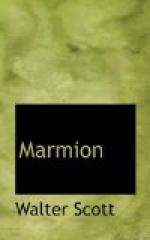line 19. Lammermoor. ’See notes to the Bride of Lammermoor, Waverley Novels, vols. xiii. and xiv.’—Lockhart.
line 22. ’The village of Gifford lies about four miles from Haddington; close to it is Yester House, the seat of the Marquis of Tweeddale, and a little farther up the stream, which descends from the hills of Lammermoor, are the remains of the old castle of the family.’—Lockhart.
Many hold that Gifford and not Gifford-gate, at the outskirts of Haddington, was the birthplace of John Knox.
Stanza ii. line 31. An ivy-bush or garland was a tavern sign, and the flagon is an appropriate accompaniment. Chaucer’s Sompnour (Prol. 666) suggested the tavern sign by his head-gear:—
’A garland hadde
he set upon his heed,
As gret as it
were for an ale-stake.’
See note in Clarendon Press ed., and cp. Epilogue of As You Like It (and note) in same series:—’If it be true that good wine needs no bush,’ &c.
line 33. ’The accommodations of a Scottish hostelrie, or inn, in the sixteenth century, may be collected from Dunbar’s admirable tale of “The Friars of Berwick.” Simon Lawder, “the gay ostlier,” seems to have lived very comfortably; and his wife decorated her person with a scarlet kirtle, and a belt of silk and silver, and rings upon her fingers; and feasted her paramour with rabbits, capons, partridges, and Bourdeaux wine. At least, if the Scottish inns were not good, it was not from want of encouragement from the legislature; who, so early as the reign of James I, not only enacted, that in all boroughs and fairs there be hostellaries, having stables and chambers, and provision for man and horse, but by another statute, ordained that no man, travelling on horse or foot, should presume to lodge anywhere except in these hostellaries; and that no person, save innkeepers, should receive such travellers, under the penalty of forty shillings, for exercising such hospitality. But, in spite of these provident enactments, the Scottish hostels are but indifferent, and strangers continue to find reception in the houses of individuals.’—Scott.
It is important to supplement this note by saying that the most competent judges still doubt whether Dunbar wrote ’The Friars of Berwick.’ It is printed among his doubtful works.
Stanza iii. Such a kitchen as that described was common in Scotland till recent times, and relics of a similar interior exist in remote parts still. The wide chimney, projecting well into the floor, formed a capacious tunnel to the roof, and numerous sitters could be accommodated with comfort in front and around the fire. Smoke and soot from the wood and peat fuel were abundant, and the ’winter cheer,’—hams, venison, &c.—hung from the uncovered rafters, were well begrimed before coming to the table.
line 48. The solan goose frequents Scottish haunts in summer. There are thousands of them on Ailsa Craig, in the Frith of Clyde, and on the Bass Rock, in the Frith of Forth, opposite Tantallon.




